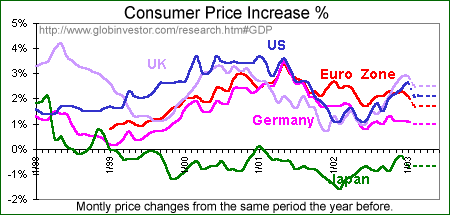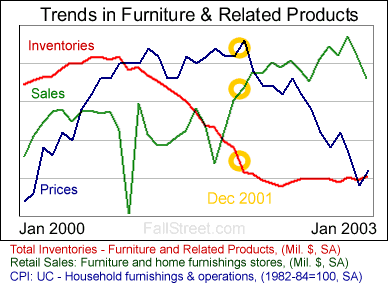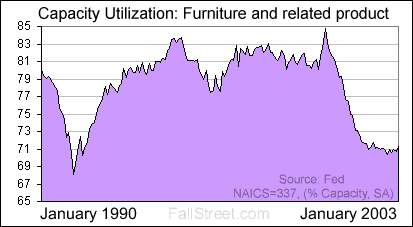March 10, 2003
The Fed’s Silent Weapon to Avert Mass Financial Destruction
12:01 AM Monday morning
Gold is up sharply, the Nikkei is trading below 8,000 for the first time in 20-years, and the dollar is weakening (oil strengthening) because U.S. Secretary of State Colin Powell said the probability of war with Iraq “is rapidly increasing.” In case you didn’t know, it is going to be another volatile week…
Economic Reports
Following last month’s surge in producer prices – even the ‘core’ PPI was up 0.9% in Jan – the most anticipated report this week is Friday’s PPI. Expectations are for a modest increase in core prices (+0.1%). Also due out Friday is one of the first indicators of March consumer confidence (Mich Sentiment). Rounding out the week is jobless claims, retail sales, another current account deficit, industrial production, and inventories.
|
Given that last week’s jobs report reignited worries of a double dip recession, every economic report could be a market moving event – a stronger than expected PPI could stoke stagflation worries, a larger than expected jobless claims number could confirm that the layoffs are mounting, and a weaker than expected production number could add to overall investor gloom. However, and not unlike the trading sessions leading into the November FOMC meeting, remember that “not even short sellers are likely to become overly stimulated by bad economic news knowing that such news could prompt the Fed to cut interest rates in a few days time” (Oct 28).
If last weeks freakish rally following the pitiful jobs report is any indication, we are in one of those weird periods when bad news could be ignored because ‘good’ things are expected to happen. These ‘good’ things - which will continue to be hyped up by Wall Street in the coming days - are the possibility of another Fed cut and positive developments on the Iraqi front.
The Fed
Last Friday two Merrill economists predicted that the Fed would cut interest rates by a quarter point on March 18. The Merrill economists also predicted that the Fed would cut rates again in May, and that “If further stimulus is needed, the Fed will start buying intermediate and long-term Treasury securities.”
I am not sure what dream world Merrill’s Kathy Bostjancic and David Rosenberg live in that allows them to make these types of predictions. However, I do know that if the Fed is going to cut the Federal Funds down to 0.75% and this still isn’t enough ‘stimulus’, they are going to do a lot more than buy Treasurys. Quite frankly, it is time for everyone to start telling the truth: if the Fed cannot stimulate things and the equity markets are declining Greenspan and company are going to buy stocks.
Comedy of Horrors
As the Nikkei busted below 8,000 Okasan Securities’ Tetsuya Ishijima had this to say:
“It's clear that we've reached the level where some kind of government response is required”
If this statement doesn’t make you chuckle it is uncertain what will. At 10,000 the Japanese government formed a Stock Buying Body to purchase crossed shares from banks, at 9,000 the Japanese government said they would purchase shares directly in the market, and at 8,500 market trading rules were rigged to hinder short sales. The horrible truth is that the Japanese government has done everything conceivably possible to boost stock prices, yet prices - not just stock prices - continue to plunge.
 |
Industry Deflation #1
Following 9/11 automobile manufacturers began to offer consumers spectacular incentives. As the chart below shows, this ploy worked wonders for a couple of months - sticker prices actually increased when GM and others offered low or no interest rate plans. However, vehicle prices have since resumed their decline as manufacturers have had to continually offer more incentives to maintain consumer interest.
 |
Industry Deflation #2
Although a bit more difficult to spot, the basic trends in the furniture related industry also reeks of deflation.
 |
A normal trend in furniture (and the US economy) – as sales pick-up inventories decline – is largely the reason why many economists assumed the US economy was turning around in early 2002. However, notice how the ‘prices’ component is threatening to reach the same level it was at in 2000. Not only is this trend is highly abnormal, it the reason why some economists – not many mind you – believe deflationary pressures are building.
Margins Matter
The major problem the US stock markets face has little to do GDP and more to do with EBITDA. To be sure, within two of the strongest components of US economy - automobiles and housing (furniture) – there are a plethora of companies with sliding margins.
|
Declining margins comment not only on the US consumers quest to find bargains, but also on the Fed’s inability to successfully stimulate aggregate demand.
Capacity Matters
The macro problem of overcapacity can not, and has not been cured by the Fed enticing consumers to take on more debt. Rather, and referring to the furniture example – wherein inventories have declined, sales have risen, but prices of dropped – the capacity overhang is still present today.
 |
The overcapacity issue represents a formidable challenge for the Fed. Greenspan can aim for a weaker dollar, which many people speculate he Fed/Treasury have been doing, in an attempt to increase exports and make US companies more competitive at home. However, there is the question of which country can absorb US exports and/or which country is not going to be hurt when their exporting strength to the US is sapped.
Conclusion
Given the geopolitical uncertainties and/or the threat of a double dip recession, it is possible that the Fed will try cutting rates again next week. However, it is unlikely that further rate cuts will be the remedy to the US’s capacity problem. Rather, even as the Fed has previously helped stimulate demand in some areas of the economy, corporate profitability has not risen congruently: it is as if consumers are only buying what is on sale.
Beyond cutting interest rates look for the Fed to take a more unorthodox approach to fighting economic weakness. This means purchasing stocks or shorting gold. These are things people rarely talk about, yet everyone knows it is crucial for the US economy that the stock markets stop sliding. As for gold, this has always been a long-term nemesis of the Fed.
“If the US was willing to spend 20 or 30 billion to secure Turkey's involvement in IRAQ, then how much do you think they would be willing to spend to prevent a meteoric rise in the price of gold and the associated collapse in confidence?” Craig Harris, Harris Capital
It is uncertain whether or not the Fed was in the markets last week – or when gold got hammered and stocks simultaneously rallied sharply following a terrifically bad payrolls number supposedly because Osama’s sons had reportedly been arrested. However, what is certain is that Japan’s plunge protecting tactics have failed miserably, and the Fed is not looking to emulate Japan by taking interest rates incrementally lower until zero is struck.
Think about it: the Fed cut by 50 basis points in November 2002 to shock the system, and in the FOMC statement the Fed suggested that the rate cuts were finished. What good, if any, would a 25 basis point cut do next week?
In sum, the Fed’s silent weapon is to purchase stocks. However, unlike Japan – who waited until investor confidence was completely shot and the exchange was on the verge of a complete collapse -- the Fed would be better served to plunge protect in a quiet and consistent manner. This is not to suggest that the Fed will be successful, or that the US economy is in strong standing so long as the Fed can hold stock prices up. Only that the Fed’s current actions of cutting interest rates and playing with the money supply are not having the desired effects.
|
|
All data and information within these pages is thought to be taken from reliable sources but there is no guarantee as such. All opinions expressed on this site are opinions and should not be regarded as investment advice.
Copyright © 2000-2003. FallStreet.com